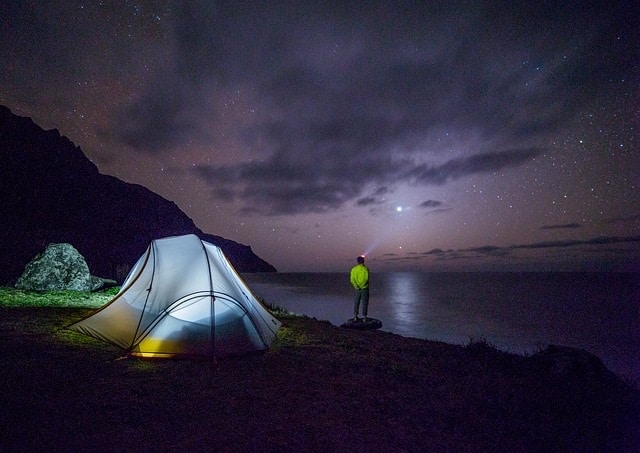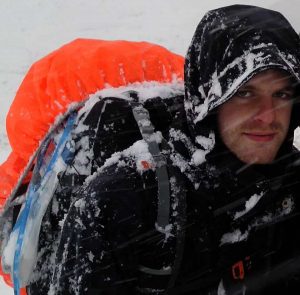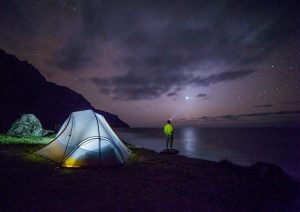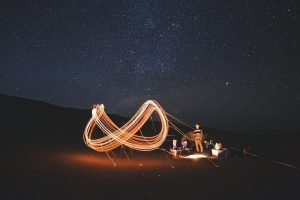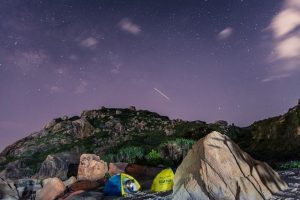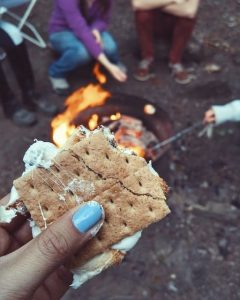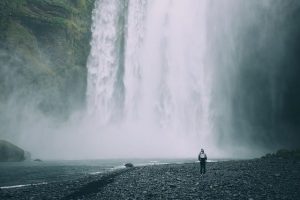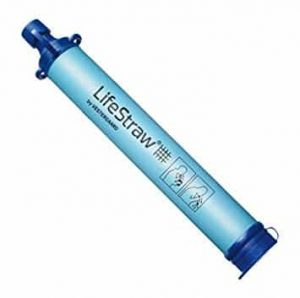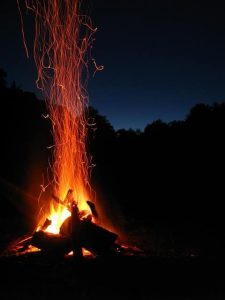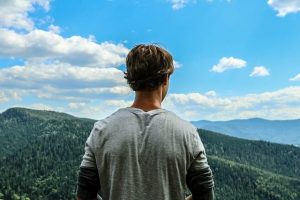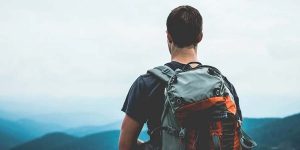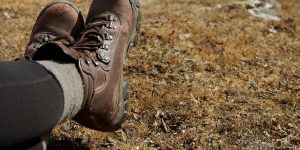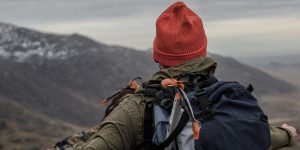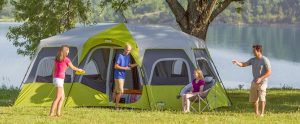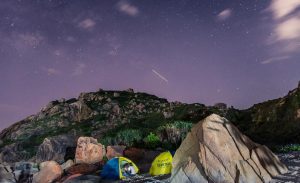How idyllic.
To leave work, head for the hills and live off the land. We all dream of getting away from the rat race, and wild camping is the perfect way to do exactly that.
And the best part? The fact you’re about to read this guide means you’re going to be prepared. And, if I had wild camping tip, just one, it would be exactly that; be prepared.
Preparation is going to mean you:
- Are More Comfortable
- Enjoy Wild Camping
- Find The Best Places To Wild Camp
- Crave To Do It Again
It doesn’t matter if you’re looking to wild camp on your own, in a group, in a tent, or in a bivvy; our complete guide to wild camping has got you covered.
In the next 10 minutes, we’ll cover every aspect of wild camping.
Looking for tips on something specific? Skip straight to the relevant section below:
Jump To Section
Wild Camping Essential Kit List
We’ve created a detailed wild camping kit list, with specific kit recommendations.
If you’re looking for a summarised wild camping checklist to use just before a trip, skip to the next section.
Before we head right into the kit list, there are two wild camping packing tips you need to know:
- Pack as light as possible
- Expect the unexpected, and pack accordingly
So, do go ultralight, but don’t sacrifice essential items.
#1 – Camping Backpack
You’re going to need a substantial backpack to carry all your gear.
If you’re wild camping alone, you’ll need something in the 60L range. If you’re part of a group and can share the load, or just camping for one night, then something in the 40L range should be sufficient.
Remember, exterior straps and webbing can increase your carrying capacity; so you’ll want plenty. I’ve strapped camping mats, sleeping bags, fire pits and dry bags to the exterior of my camping pack in the past, leaving more space inside the pack for essentials.
I’ve wild camped alone and in groups, and use a Vango 60L+10L (the 10L compartment is expandable). There’s more than enough space here, and mine came inclusive of a (highly visible!) waterproof cover which I’d recommend – to keep your gear dry.
Click the link below to check prices for the best wild camping backpacks.
Show Wild Camping Backpack Deals
#2 – Tent Or Bivvy Bag
Now you’ve got a backpack to carry your wild camping kit, you’ll need a suitable tent or bivvy.
The options are endless. And, I’ve written up a buyer’s guide to wild camping tents and bivvies here.
There’s a tonne of high-quality brands out there including MSR, Vango, Nemo, Berghaus and more.
The main thing you’ll need to look out for, is the HH rating (this determines how waterproof a tent is).
For fair weather, 1500mm is fine. For high winds, heavy rain and snow, you’ll want something in the 3000mm-5000mm range.
Alongside our guide, there’s some good deals on wild camping tents below.
#3 – Portable And Foldaway Camp Stove
If you want to go ultralightweight, I’d recommend a portable foldaway camping stove. They pack away into a box so small you can fit it in your pocket.
Etekcity and Reehut are both reasonably priced, but if you want to go with a reputable brand, try the MSR PocketRocket 2.
#4 – Breathable And Waterproof Jacket
Even if you’re planning to camp in fair weather, refer to our top wild camping tip; be prepared.
I can tell you right now, there’s nothing worse than getting wet and having no way of drying off. A good waterproof jacket is the insurance you need to make this camping trip comfortable.
Find a jacket that uses a fabric with breathable properties. Getting hot and sweaty is just as fun as getting soaked in the rain; none at all. A breathable jacket will regulate temperature well, and dry quickly.
A couple of branded options are the Outdoor Research Horizon, The North Face Men’s Resolve 2 and for Women, the Columbia Women’s Switchback II.
There’s a massive range of waterproof jackets on deal now, right from the low budget through to the high end.
#5 – Hiking Trousers
As we’re on a space saving train here, opt for a hiking trouser that zips off to make a pair of shorts, rather than carrying shorts separately.
For fair weather, pretty much any pair of hiking trousers from the likes of Columbia, Outdoor Research or Berghaus will do.
However, if you plan to wild camp in harsher conditions, look at a more technical pair of trousers.
Be warned though, this does get expensive. I’ve used a pair of Mountain Equipment Ibex Softshell trousers for almost every wild camping trip (in all weather) for over 5 years.
#6 – Waterproof Hiking Boots & Merino Wool Socks
Whether you plan to do a 1km round trip (to camp and back) or plan to hike 20km a day; waterproof hiking boots and merino wool socks will make your experience more comfortable.
If you’re looking for brand recommendations, I’ve used a pair of Merrell hiking boots for over 5 years, I don’t even think they make them anymore; very durable. Mine are like the current Moab GTX.
In all honesty, I can’t give my Merrell’s enough praise.
Got your boots? Next – merino wool socks will wick moisture away from your feet; whether that be sweat or water from the puddle you just stepped in : )
Brand wise, I’ve got a few different pairs, they’re not all hiking specific (I use a lot of my gear for a range of outdoor activities).
Smartwool Phd Light Elite and the Bridgedale Speed Trail sock are just a few I own. For hiking specific socks, there’s a cool brand called Darn Tough.
#7 – Sleeping Bag
You really need to decide the “average” temperature you’ll be camping in. I know it’s a tough one, but it really helps to purchase the right sleeping bag for wild camping.
Some bags are designed for sub minus conditions, others for summer. But then, there are allrounders.
Most good sleeping bag brands will give a recommended temperature rating. For instance, my Vango says -10 up to +4. Realistically, I’ve used it in -14 with no problems, but above +15 it starts to get a little uncomfortable.
But, there’s a problem. I’d say even when it’s packed down, it takes up maybe 8-10L of space in my pack.
So, what you need to look for is an “ultralight sleeping bag”. If a manufacturer doesn’t specify “ultralight”, make sure you take note of the weight and packed size before making a purchase.
Ideally, you’ll want to purchase a dry bag. This means you can attach the sleeping bag to the outside of your rucksack, rather than taking up valuable space inside.
#8 – Sleeping Mat
You don’t have to have a sleeping mat; some campers can do without them. If you can’t, there’s two options:
- Basic fold out mat
- Inflatable mat
Your basic mat will insulate you from the cold and give some level of comfort even on rocky ground. At around $15, they’re nice and cheap too.
The inflatable camping mat is going to be bigger, heavier but offer more comfort; starting at around $40.
Personally, I externally pack a basic foldout mat on my rucksack, as my sleeping bag is duck down and offers plenty of comfort – no need for an inflatable.
#9 – Insect Repellent
Midges and other pests can make a wild camping trip miserable, so make sure you protect yourself against them.
#10 – Knife
A good all-round camping knife can be used for making kindling, lighting fires with a steel or chopping veggies for dinner. Oh, and if you have watched 127 Hours, it can also be used to cut your arm off.
There’s plenty of good (and cheap) brands out there. TAC Force is one of the better known camping knife brands.
#11 – Head Torch
A head torch is going to be useful if you’ve ran out of fire wood, setting up camp after dusk, or wanting to leave before dawn; not to mention it makes going to the toilet in the night a little easier.
I’ve had a Petzl head torch for a few years. They cost $30-40, although there are budget options available.
#12 – Dry Bag
I use a dry bag to keep some essentials safe and dry. This might include your phone, wallet, kindling, a spare set of socks and a fresh t-shirt.
For the essentials, a small 10L dry bag will be more than enough. When I take one, I attach it to the exterior of my pack, so I don’t have to sacrifice interior capacity of my rucksack.
Sea To Summit offer a high quality dry bag.
#13 – A Means To Light A Fire
If you plan on cooking on a fire, or even a stove, you’ll need either a fire steel, or a lighter. If you’re going down the lighter route, go with something wind resistant like a Zippo and just leave it in your pack.
If you’ve not wild camped before and want to use a steel, I’d suggest taking a lighter as a backup; lighting a fire with a steel isn’t as easy as it looks.
#14 – Map And Compass
Routes are notoriously easy to follow in the light and fair weather. But, I’ve been victim of Mother Nature showing her hand, and being caught in a snow blizzard; we couldn’t see a thing.
And, that’s where a map and compass can save your life.
Oh, and make sure you know how to use them!
#15 – Water Bottles
We’re trying to travel ultralight here, so carry what water you can in bottles, but expect to have to source water on your travels.
#16 – Water Purifier
When water runs out, you’re going to need to find some more. Sure, you can drink it as it is, but you’d be surprised how many germs can be picked up.
Grabbing water from a stream running downhill, how do you know there’s not a dead animal lying upstream?
We’ll jump into how to source and purify water later, but for now, you’ll need a purification system, like The Life Straw.
Show Portable Water Purifier Deals
#17 – First Aid Kit
There’s a good chance you’re not going to pitch next to a hospital. A basic First Aid kit could literally save your life. For what they cost and weigh, you’d be silly not to take one.
Any First Aid kit is better than no First Aid kit.
#18 – Trowel
When you go to the toilet, you’ll need to make sure you bury your business. Unless you prefer to dig with your hands, a trowel might be useful.
#19 – Sun Cream
Even on cloudy days, you’ll be attacked by UV rays. You might not notice it when you laze around in the garden, but that’s because you don’t sit outside all day.
You will get sun burnt if you don’t apply sun cream daily. Take a travel sized sun cream bottle with you.
#20 – Food
Again, we’ll dig into this in detail later. If you’ve got the space and can handle the weight, you can take ingredients with you. Alternatively, pre-cook meals, or buy pre-cooked meals.
Mountain House do meals specifically for wild campers, although the supermarkets have a variety on offer too.
#21 – Spork And A Mess Tin
Mess tins are used in all sorts of scenarios; even the Army.
Essentially, you cook and eat out of the same metal pot. And combined with a spork (a spoon and fork in one), that’s all you’ll need to cook and eat.
#22 – Camera
I always like to take some pictures and footage when I’m wild camping. You just never know what you’re going to come across – whether that’s a freaky plant or playful wildlife.
For those looking to take pictures, I’d recommend reading our guide to The Best DSLR Camera For Beginners.
For capturing video, I rely on my trusty GoPro. A selfie stick is an optional extra : )
The 22-Point Wild Camping Check List
We realise that’s a lot to take in, so we’ve summarised it into a simple checklist here, so you can tick items off when you pack for your trip.
#1 – Camping Backpack
#2 – Tent Or Bivvy Bag
#3 – Portable And Foldaway Camp Stove
#4 – Breathable And Waterproof Jacket
#5 – Hiking Trousers
#6 – Waterproof Hiking Boots & Merino Wool Socks
#7 – Sleeping Bag
#8 – Sleeping Mat
#9 – Insect Repellent
#10 – Knife
#11 – Head Torch
#12 – Dry Bag
#13 – A Means To Light A Fire
#14 – Map And Compass
#15 – Water Bottles
#16 – Water Purifier
#17 – First Aid Kit
#18 – Trowel
#19 – Sun Cream
#20 – Food
#21 – Spork And A Mess Tin
#22 – Camera
Where To Wild Camp (Legally)
You can’t just pitch up anywhere. Different places have different rules regarding where you can legally wild camp.
Where To Wild Camp In The UK
The rules on where we can wild camp in the UK are straight forward.
England & Wales
Dartmoor National Park has open-access, and that means that wild campers are legally allowed here.
However, the rest of England & Wales does not have open-access. So, wild camping here, is technically illegal without the landowner’s permission.
That doesn’t mean people don’t do it. Lots of people wild camp throughout the Lake District, especially on Scafell Pike and in Snowdonia National Park, without any issues.
Scotland
Scotland has an open-access approach to wild campers. That means wild campers can camp when and where they like.
Where To Wild Camp In The USA
So, where can you wild camp in the USA legally?
First off, it’s worth grabbing this pocket book.
It’s the “Hiking In The USA” publication from Lonely Planet, and it’s a great resource for people looking to wild camp.
There’s two places you’ll be set to go in the USA:
- National Forests and Grasslands
- Bureau of Land Management (BLM)
National Forests & Grasslands
US National Forests & Grasslands are usually free of charge and open to wild campers. Most of these camping spots will have a 14-day limit.
Each forest and grassland will have its own set of rules, so make sure you check first.
To find a legal wild camping spot, use the National Forest Map Locator.
Bureau of Land Management (BLM)
Typically, BLM is found in Western States. It’s land that’s managed by the public. And, you’re good to go here if you steer clear of campsites that have already been developed.
Be warned, some areas of BLM are used for other purposes (such as livestock grazing), so you’ll need to check each spot beforehand.
Finding BLM is a bit tricky. What you’ll need is an overlay file for Google Maps. You can search Google for “BLM Google Earth Overlay” for the most updated version.
Picking The Best Pitch
So, you’ve found land that you can legally camp, and you’re en-route, what’s next?
Picking the best spot to camp…
Protection From The Elements
If it’s windy, try and pitch somewhere that offers some coverage from the directionality of the wind, like a small rock face.
And, if it’s raining heavily, or the sun is unbearable, try and pitch below trees that offer some protection.
Water Source
Even if you plan to stay for just a few days, you’ll need to collect water.
Once you’ve determined the best source of water, pitch up as close as possible (in the USA, you’ll usually have to pitch at least 200ft away from a water source, legally).
Flat Land & Scenery
Avoid rocky patches and slopes for the best night’s sleep. And, for when you wake up, pitch your tent so when you crawl out, you’ve got the best view possible – make this an experience you’ll never forget.
Food & Drink – In The Wild
The Foodies Guide To Cooking In The Wild
What food do you take wild camping?
Good question. It all depends on whether you’re restricted by weight, and the weather forecast (perishable items will go off quicker in warm conditions).
Non-Perishable Ingredients
Non-perishable food items are the most suitable for wild camping trips. Not just because they don’t need to be accompanied by a cool box, but they are generally lightweight.
- Pasta and noodles (readymade meals)
- Tinned food (tuna, sliced peaches and beans)
- Any dehydrated food (apricots)
- Cereal bars
- Bread
I usually stock up on a couple of pre-made packet meals which can be found in supermarkets, but there are also specifically designed wild camping foods from brands like Mountain House.
Taking Meals With You
I rarely take ingredients with me to cook. What I will do a week or so before hand, is freeze a portion of whatever I’m cooking. Taking this (frozen), it will last 2-3 days on the trail.
A few ideas for some meals you could prepare include:
- Beef slow pot (beef, vegetables, stock cube, salt, pepper, gravy – slow cook for 6-7 hours).
- Chicken casserole (casserole sauce, vegetables, stock cube, chicken, flour to thicken sauce – cook for 5-6 hours).
Foraging For Food Whilst Camping
If you’re determined to be a hardcore wild camper, why not forage for food on your trip? If this is something you plan on doing I’d suggest two things:
- Always take a few pre-made packet meals as a backup.
- Get a relevant foraging book to help you determine what items are poisonous.
On Amazon right now, there are a tonne of books on foraging. There’s some super specific books there too, including “Midwest Foraging: 115 Wild and Flavorful Edibles from Burdock to Wild Peach (Regional Foraging Series)”.
How To Source Water And Filter For Drinking
You’re not going to be able to take enough fluid with you to cover your whole trip. The average person consumes around 2-3L of water per day. But, that figure is going to catapult skywards when you throw in outdoor activities.
How To Source Water
Flowing water From Streams And Rivers
Flowing clear water is always the freshest. Our top tip here is to always find the highest point of free-flowing water possible.
The further down a stream you are, the more likely there is to be bacteria in what you’re drinking.
Animals roam hills and mountains. If they perish near a water source, bacteria will grow on them and slowly find its way into the water source. Imagine it’s you, 100ft downstream drinking this bacteria; not nice.
Stagnant Water From Ponds And Lakes
If you have no other option, your next best bet is a pond or lake. But, stagnant water will have attracted a lot more bacteria than free-flowing water, so your water purification system needs to be up to the challenge.
Winter Water Sourcing: Snow And Ice
Like with our free-flowing example, try and find snow and ice that is as high as possible – less chance of contamination.
Should You Eat Snow And Ice?
If you have your portable stove handy, get boiling. There’s two reasons for boiling snow and ice:
- It will remove most bacteria.
- Snow and ice will not just lower your body temperature, your body will need to work hard to replenish heat, and that uses energy.
Purifying Water Ready For Drinking
We always recommend taking a small water purification device such as The Life Straw, especially over purification chemicals, and definitely over not filtering at all.
Before filtering through a life straw, you can pre-purify the water by boiling it. Boiling the water for just 1-2 minutes will remove most bacteria, and your Life Straw will do the rest.
How To Make A Fire – Like a Boss
I haven’t met a wild camper who doesn’t love, or have, a fire on their trips.
There’s one problem. They are generally frowned upon. That’s because of two things:
- Any ember left unattended causes a fire threat to the surrounding environment.
- Most people leave rubbish and “fire mess” after they camp.
And, it seems when one person sees another has had a fire and left a mess, they feel obliged to do the same.
So, we’re not condoning leaving a fire unattended, or mess after you camp, but sometimes, a fire is needed; for warmth.
Only make a fire where you are legally allowed to do so.
How To Leave No Trace Of A Fire
First, let’s quickly run through the best process to leave no trace of a fire.
- If you can attach a fire stand or fire pit to your pack – do so.
- Raise the pit on stones to avoid damaging the floor space.
- Clear the area of any debris that might catch fire.
How To Build A Camp Fire
What You Need To Build A Camp Fire
- Means to light a fire – lighter, matches or a fire steel
- Trowel
- Water
- Tinder
- Kindling
- Logs and branches
Prepping The Fire Area
Hopefully, you took our advice and are near a water source. Have water readily available in case surrounding grass or plants catch fire. Having your small trowel ready to throw on some loose dirt is also a good precaution.
With these precautions in place, clear the area, including 2-3ft around the fire. This will reduce the risk of setting fire to anything but the campfire.
You can douse an area that’s 1-2ft away from, but around the whole circumference of the fire. If embers to pop out of the fire, the water will quickly absorb them (if you water too close to the fire, the heat will evaporate the water quickly and it will be of no use).
Camp Fire Starting Basics
Step #1 – Get An Ember To Your Tinder
Tinder is the easiest lighting and fastest burning of your materials. It will take an ember and create a small heat source. Examples of great tinder include:
- Dry grass
- Moss
- Fungus
- Bark
This is really used for those using a steel to create sparks (hoping one of these sparks creates an ember). If you’re using a strong lighter, you’ll literally set the tinder on fire and then get it straight onto the kindling.
Keep sparking the fire steel, aiming towards the tinder, until an ember catches.
Gently blow on the ember to strengthen it.
Step #2 – Move The Ember And Tinder To Your Kindling
Next, carefully transfer the ember (or flame, for those using a lighter) you’ve created, with the tinder, over to your kindling. Nurse this with a gentle blow, and it will catch a flame. Examples of great kindling include:
- Big pieces of bark
- Dried leaves
- Small sticks
Step #3 – Feed The Fire
You’ll need to slowly build up the fire with kindling over 4-5 minutes to make the flame big enough to add logs and branches (all dry).
If you add larger pieces of wood too soon, it will smother the fire and it will go out, so don’t just throw it all on in one go.
If you have your knife handy (or even better, an axe) try and break the branches into chunks around 2-3x bigger than the kindling, and slowly increase the size.
Step #4 – Put Out The Fire
Don’t leave your camp before dousing the fire with water and ensuring it’s out, especially in dry areas of the world. Embers can still create flames hours after the fire has “gone out”.
#1 Wild Camping Rule: Leave No Trace
The only reason we’re able to enjoy true wild camping, is because the people before us, left no trace. And, we should be aiming to do the same.
Site Rules
Prepare your trip, know your routes and know your sites. Check if there are any specific rules.
Breaking these rules doesn’t just impact the environment, it will also ensure that finding wild camping spots becomes harder and harder, as rules tighten.
Where Possible, Don’t Disrupt The Land
Think about everything you are doing. Is there a baron dry area that could be camped on rather than a wet one? Try to leave as little a foot-print as possible.
Toilet Etiquette
The only reason for disrupting the land is to properly dispose of waste, or to leave no trace of a fire.
If you need to go, dig a hole that’s at least 8 inches deep (and away from where you are camping).
BONUS: Resources For Wild Campers
I’ve spent a tonne of time not just wild camping, but browsing wild camping websites over the years. And, I’ve come across some awesome resources that need to be mentioned.
I hope you enjoy them as much as I have.
Cheap Wild Camping Equipment And Gear
We’ve found a tonne of websites with crazy offers on cheap wild camping gear, but it’s rare that they can beat Amazon. Maybe I’m just lazy, but it’s where I grab most of my camping equipment.
View Wild Camping Gear On Amazon
MCQ Bushcraft – YouTube Channel
Looking to gain a few extra bush craft skills before your trip? Look no further than MCQ Bushcraft’s YouTube channel, a range of educational videos for wild campers and people exploring the bush.
Like the video below, covering essential knots for camping.
Bushcraft Forum
Looking for an answer to something specific? Bushcraftuk.com has the people here with the knowledge to help.
Check out the forum here.
OurBumble European Camping Database
OurBumble has a great map overlay of over 750 wild camping spots throughout Europe.
Check out their map here.
Wild Camping Spots In The USA
Checkout the National Forest Map Locator and also the Lonely Planet book “Hiking In The USA”, which includes a range of spots for wild campers.
What’s Next?
Thanks for reading out Beginner’s Guide To Wild Camping.
Don’t forget to sign up to our email list, and we’re always happy to hear about your recent trips, so feel free to leave a comment below.
